lock Alfa Romeo GT 2008 Owner handbook (in English)
[x] Cancel search | Manufacturer: ALFA ROMEO, Model Year: 2008, Model line: GT, Model: Alfa Romeo GT 2008Pages: 271, PDF Size: 5.57 MB
Page 199 of 271

IN AN EMERGENCY
197
Dipped beam headlights
(fig. 25)
To change the bulb, proceed as follows:
– Remove the protective cover releasing
the catches.
– Disconnect the electric connector (A).
– Release the bulb catch (B).
– Remove the bulb and replace it.
– Fit a new bulb, making the tabs of the
metallic part coincide with the grooves on
the reflector, then hook the bulb holder catch
(B).
– Re-connect the electric connector (A).
– Refit the protective cover correctly.
fig. 25
A0A0162b
Main beam headlights
(fig. 27)
To change the bulb, proceed as follows:
– Remove the protective cover releasing
the catches.
– Disconnect the electric connector (A).
– Release the bulb catch (B).
– Remove the bulb and replace it.
– Fit a new bulb, making the tabs of the
metallic part coincide with the grooves on the
reflector, then hook the bulb holder catch (B).
– Re-connect the electric connector (A).
– Refit the protective cover correctly.
fig. 27
A0A0164b
Front side lights(fig. 26)
To change the bulb, proceed as follows:
– Remove the protective cover releasing
the catches.
– Using the extension (A), integral with
the bulb holder (B), withdraw the bulb hold-
er itself which is snap-fitted.
– Remove the bulb (C), pushing gently
and turning counter-clockwise.
– Change the bulb and re-insert the bulb
holder making sure that it clicks into place;
also check that the bulb is in the correct po-
sition looking at the lamp from outside.
– Refit the protective cover correctly.
fig. 26
A0A0342b
Page 200 of 271

IN AN EMERGENCY
198
– Replace the bulb;
– Refit the bulb holder turning counter-
clockwise and check that it is secured cor-
rectly;
– Refit the transparent.SIDE DIRECTION INDICATORS
(fig. 30)
– Push the transparent cover towards the
rear of the car to compress the catch (A).
Release the front part and remove this unit.
– Turn the bulb holder (B) counter-clock-
wise and remove it from the cover.
– Remove the snap-fitted bulb and replace it.
– Insert the bulb holder (B) in the trans-
parent cover, then position the unit mak-
ing sure the catch clicks into place (A).
fig. 29
A0A0626b
fig. 30
A0A0166b
FRONT DIRECTION
INDICATORS
(fig. 28-29)
To change the bulb, proceed as follows:
– Using the screwdriver provided, remove
the transparent unit operating on the two
metal clips as shown in the figure;
– Turn the bulb holder clockwise (A) and
remove it;
– Remove the bulb (B) pushing gently
and turning counter-clockwise;
fig. 28
A0A0625b
Page 201 of 271
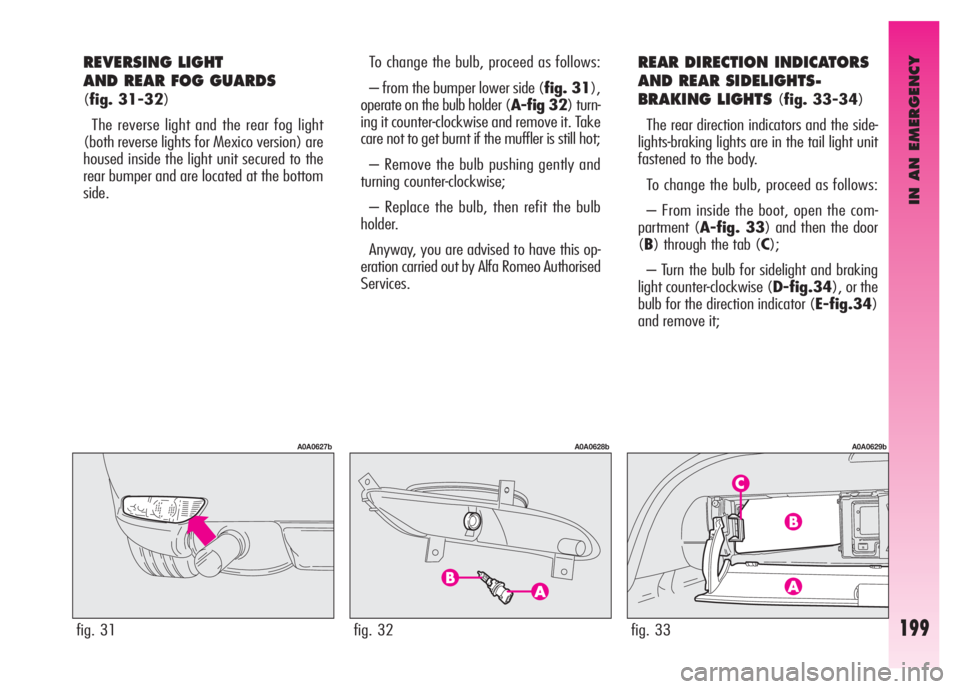
IN AN EMERGENCY
199
REVERSING LIGHT
AND REAR FOG GUARDS
(fig. 31-32)
The reverse light and the rear fog light
(both reverse lights for Mexico version) are
housed inside the light unit secured to the
rear bumper and are located at the bottom
side.
fig. 31
A0A0627b
fig. 33
A0A0629b
To change the bulb, proceed as follows:
– from the bumper lower side (fig. 31),
operate on the bulb holder (A-fig 32) turn-
ing it counter-clockwise and remove it. Take
care not to get burnt if the muffler is still hot;
– Remove the bulb pushing gently and
turning counter-clockwise;
– Replace the bulb, then refit the bulb
holder.
Anyway, you are advised to have this op-
eration carried out by Alfa Romeo Authorised
Services.REAR DIRECTION INDICATORS
AND REAR SIDELIGHTS-
BRAKING LIGHTS
(fig. 33-34)
The rear direction indicators and the side-
lights-braking lights are in the tail light unit
fastened to the body.
To change the bulb, proceed as follows:
– From inside the boot, open the com-
partment (A-fig. 33) and then the door
(B) through the tab (C);
– Turn the bulb for sidelight and braking
light counter-clockwise (D-fig.34), or the
bulb for the direction indicator (E-fig.34)
and remove it;
fig. 32
A0A0628b
Page 202 of 271
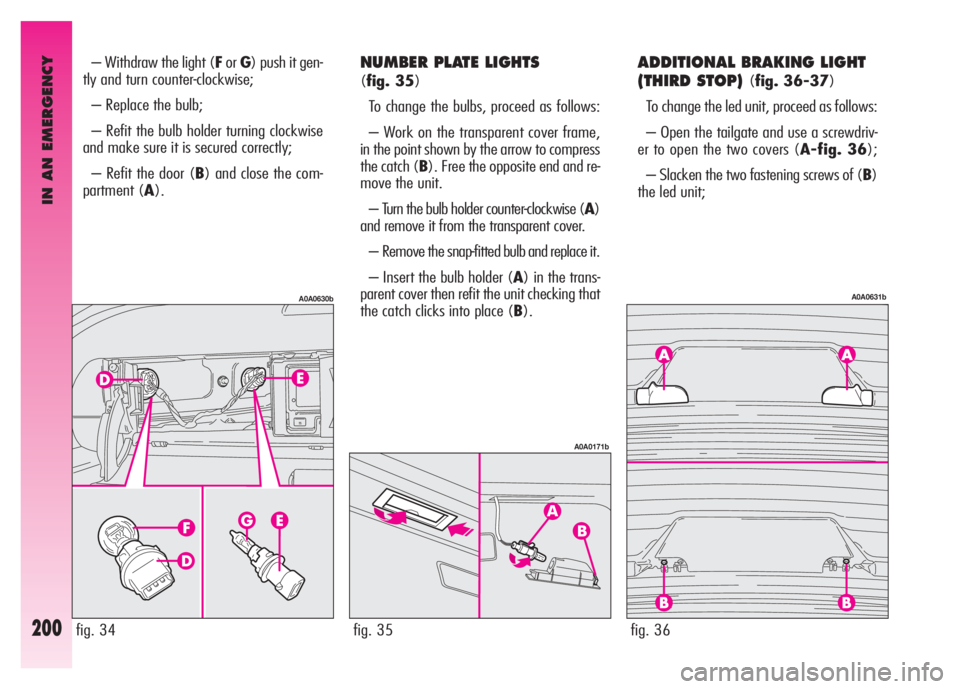
IN AN EMERGENCY
200
NUMBER PLATE LIGHTS
(fig. 35)
To change the bulbs, proceed as follows:
– Work on the transparent cover frame,
in the point shown by the arrow to compress
the catch (B). Free the opposite end and re-
move the unit.
– Turn the bulb holder counter-clockwise (A)
and remove it from the transparent cover.
– Remove the snap-fitted bulb and replace it.
– Insert the bulb holder (A) in the trans-
parent cover then refit the unit checking that
the catch clicks into place (B).
ADDITIONAL BRAKING LIGHT
(THIRD STOP)
(fig. 36-37)
To change the led unit, proceed as follows:
– Open the tailgate and use a screwdriv-
er to open the two covers (A-fig. 36);
– Slacken the two fastening screws of (B)
the led unit;
fig. 35
A0A0171b
fig. 36
A0A0631b
A0A0630b
– Withdraw the light (ForG) push it gen-
tly and turn counter-clockwise;
– Replace the bulb;
– Refit the bulb holder turning clockwise
and make sure it is secured correctly;
– Refit the door (B) and close the com-
partment (A).
fig. 34
Page 211 of 271
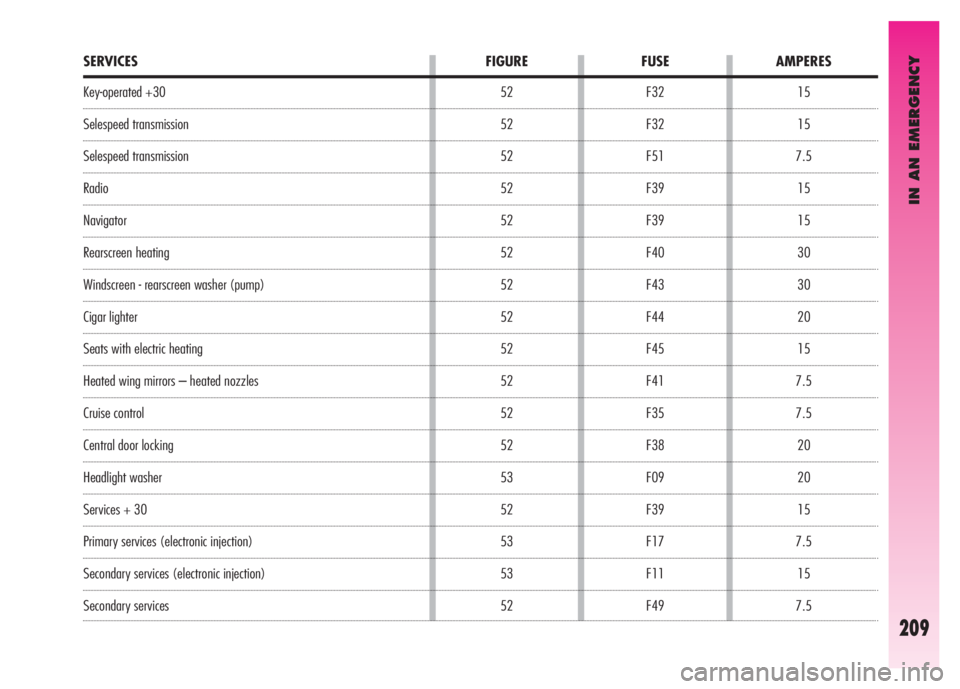
IN AN EMERGENCY
209
15
15
7.5
15
15
30
30
20
15
7.5
7.5
20
20
15
7.5
15
7.5 F32
F32
F51
F39
F39
F40
F43
F44
F45
F41
F35
F38
F09
F39
F17
F11
F49
SERVICES FIGURE FUSE AMPERES
Key-operated +30
Selespeed transmission
Selespeed transmission
Radio
Navigator
Rearscreen heating
Windscreen - rearscreen washer (pump)
Cigar lighter
Seats with electric heating
Heated wing mirrors – heated nozzles
Cruise control
Central door locking
Headlight washer
Services + 30
Primary services (electronic injection)
Secondary services (electronic injection)
Secondary services52
52
52
52
52
52
52
52
52
52
52
52
53
52
53
53
52
Page 213 of 271
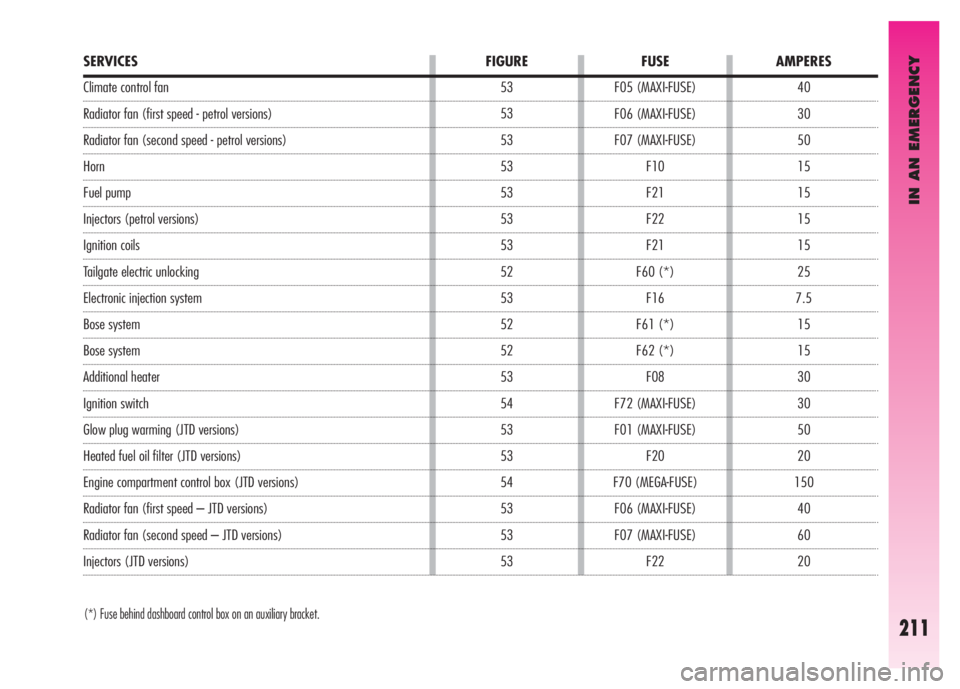
IN AN EMERGENCY
211
40
30
50
15
15
15
15
25
7.5
15
15
30
30
50
20
150
40
60
20 F05 (MAXI-FUSE)
F06 (MAXI-FUSE)
F07 (MAXI-FUSE)
F10
F21
F22
F21
F60 (*)
F16
F61 (*)
F62 (*)
F08
F72 (MAXI-FUSE)
F01 (MAXI-FUSE)
F20
F70 (MEGA-FUSE)
F06 (MAXI-FUSE)
F07 (MAXI-FUSE)
F22 53
53
53
53
53
53
53
52
53
52
52
53
54
53
53
54
53
53
53
SERVICES FIGURE FUSE AMPERES
(*) Fuse behind dashboard control box on an auxiliary bracket.
Climate control fan
Radiator fan (first speed - petrol versions)
Radiator fan (second speed - petrol versions)
Horn
Fuel pump
Injectors (petrol versions)
Ignition coils
Tailgate electric unlocking
Electronic injection system
Bose system
Bose system
Additional heater
Ignition switch
Glow plug warming (JTD versions)
Heated fuel oil filter (JTD versions)
Engine compartment control box (JTD versions)
Radiator fan (first speed – JTD versions)
Radiator fan (second speed – JTD versions)
Injectors (JTD versions)
Page 215 of 271

IN AN EMERGENCY
213
IF THE CAR IS TO BE TOWED
The tow ring supplied with the car is
housed in the tool box under the boot mat.
To install the tow ring, proceed as follows:
– Take the tow ring from the tool box.
– Remove the cover (A) snap-fitted on
the front (fig. 55) or rear (fig. 56)
bumper. To do this, using the flat-bladed
screwdriver provided, protect the tip with a
soft cloth to avoid damaging the car.– Firmly screw the ring in its housing.
fig. 55 - front
A0A0650b
fig. 56 - rear
A0A0670b
Before tightening the ring
carefully clean the thread-
ed housing. Before begin-
ning to tow the car, make sure that
the ring is firmly tightened in its
threaded housing.
Before starting to tow,
turn the ignition key to
MAR and back to STOP,
again without removing it. Re-
moving the key automatically en-
gages the steering lock resulting in
the impossibility to steer the
wheels. When towing remember
that without the help of the engine
brake and power steering greater
effort is required on the pedal and
steering wheel. Do not use flexible
cables for towing and avoid jerks.
During towing operations make
sure that fastening the joint to the
car does not damage the compo-
nents in contact with it. When tow-
ing the car, it is compulsory to fol-
low specific traffic regulations con-
cerning both the towing device and
behaviour on the road.
Page 217 of 271

IN AN EMERGENCY
215
– In motorways pileups, especially with
poor visibility, the risk of being involved in
other crashes is high. Leave the car imme-
diately and go beyond the guard-rail.
– If doors are blocked, do not try to get
out of the car breaking the windscreen which
is stratified. The windows and rear screen
are easier to break.
– Remove the ignition key of the cars in-
volved.
– If you note a smell of fuel or other chem-
ical products, do not smoke and have a cig-
arette stubbed out.
– To put out fires, even small ones, use
the extinguisher, blankets, sand, or earth.
Never use water.
– If use of the lighting system is not nec-
essary, disconnect the battery negative ter-
minal (–).IN THE EVENT
OF AN ACCIDENT
– It is important to keep calm.
– If you are not directly involved, stop at
least a few dozen metres away from the ac-
cident.
– On motorways, stop without blocking
the emergency lane.
– Turn the engine off and the hazard warn-
ing lights on.
– At night, illuminate the place of the ac-
cident with the headlights.
– Take care, do not risk being run over.
– Signal the accident placing the triangle
at regulation distance in a clearly visible
place.
– Call the emergency organisation, giving
the most accurate information possible. On
motorways use the special phones provid-
ed.
IF PEOPLE ARE INJURED
– An injured person must never be aban-
doned. Helping is compulsory also for per-
sons not directly involved in the accident.
– Do not crowd around injured people.
– Reassure the injured person that help
is on the way, and stay near to overcome
any panic.
– Release or cut the seat belt restraining
injured persons.
– Do not give injured persons anything
to drink.
– An injured person should never be
moved except in the following circum-
stances.
– Remove an injured person from the car
only in danger of fire, sinking or falling.
When removing an injured person: do not
pull the limbs or bend the head and keep
the body as horizontal as possible.
FIRST AID KIT
In addition to the first-aid kit, it is also
wise to keep an extinguisher and a blan-
ket in the car.
Page 219 of 271

CAR MAINTENANCE
217
SCHEDULED MAINTENANCE PROGRAMME
20 40 60 80 100 120 140 160 180Thousands of km
Check tyre conditions/wear and adjust pressure if necessary
Check operation of lighting system (headlights, direction indicators,
hazard warning lights, boot, passenger compartment, glovebox lights, warning lights, etc..)
Check operation of windscreen washer system, adjust spray jets
Check position/wear of windscreen/rearscreen wiper blades
Check operation of front disk brake pad wear indicator
Check wear conditions of rear disk brake pads
Sight check the conditions of: body exterior, underbody protection, stiff pipes
and hoses (exhaust - fuel supply - brakes), rubber parts
(boots - sleeves - bushes etc..)
Check cleanness of locks, bonnet and boot and lever cleanness, and lubrication
Sight inspect accessory drive belt conditions
Check handbrake lever stroke adjustment
Check antievaporation system (petrol versions)
Change air cleaner cartridge (petrol versions)
Change air cleaner cartridge (JTD versions)
Top up fluid levels (engine coolant, brakes, windscreen washer, battery, etc..)
●●●●●●●●●
●●●●●●●●●
●●●●●●●●●
●●●●●●●●●
●●●●●●●●●
●●●●
●●●●●●●●●
●●●●●●●●●
●●
●●●●
●●
●●●●
●●●●●●●●●
●●●●●●●●●
Page 221 of 271
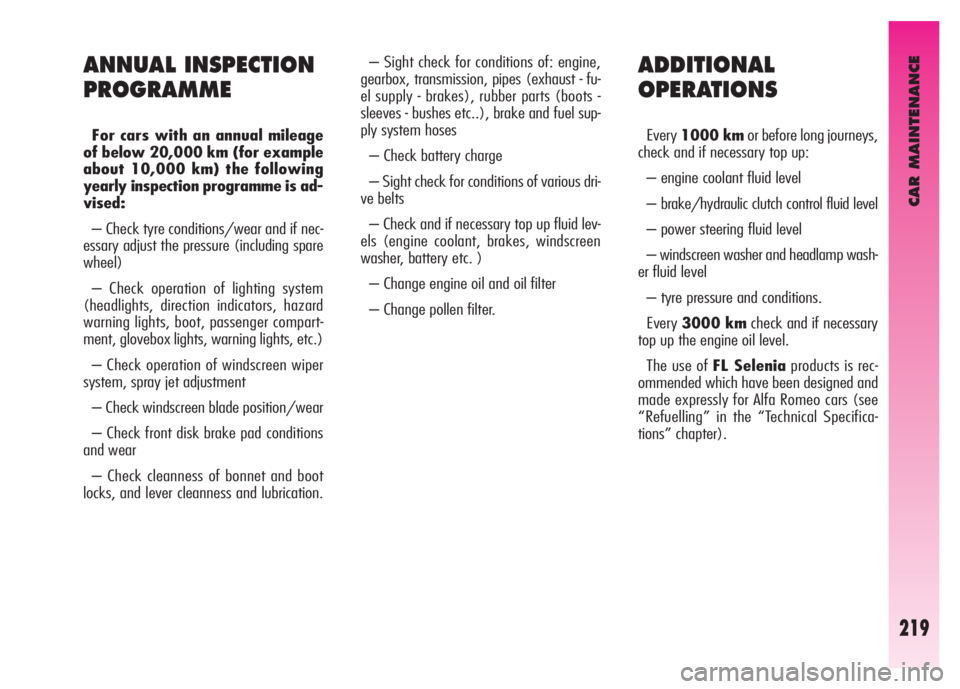
CAR MAINTENANCE
219
ADDITIONAL
OPERATIONS
Every 1000 kmor before long journeys,
check and if necessary top up:
– engine coolant fluid level
– brake/hydraulic clutch control fluid level
– power steering fluid level
– windscreen washer and headlamp wash-
er fluid level
– tyre pressure and conditions.
Every 3000 kmcheck and if necessary
top up the engine oil level.
The use of FL Seleniaproducts is rec-
ommended which have been designed and
made expressly for Alfa Romeo cars (see
“Refuelling” in the “Technical Specifica-
tions” chapter).
ANNUAL INSPECTION
PROGRAMME
For cars with an annual mileage
of below 20,000 km (for example
about 10,000 km) the following
yearly inspection programme is ad-
vised:
– Check tyre conditions/wear and if nec-
essary adjust the pressure (including spare
wheel)
– Check operation of lighting system
(headlights, direction indicators, hazard
warning lights, boot, passenger compart-
ment, glovebox lights, warning lights, etc.)
– Check operation of windscreen wiper
system, spray jet adjustment
– Check windscreen blade position/wear
– Check front disk brake pad conditions
and wear
– Check cleanness of bonnet and boot
locks, and lever cleanness and lubrication.– Sight check for conditions of: engine,
gearbox, transmission, pipes (exhaust - fu-
el supply - brakes), rubber parts (boots -
sleeves - bushes etc..), brake and fuel sup-
ply system hoses
– Check battery charge
– Sight check for conditions of various dri-
ve belts
– Check and if necessary top up fluid lev-
els (engine coolant, brakes, windscreen
washer, battery etc. )
– Change engine oil and oil filter
– Change pollen filter.